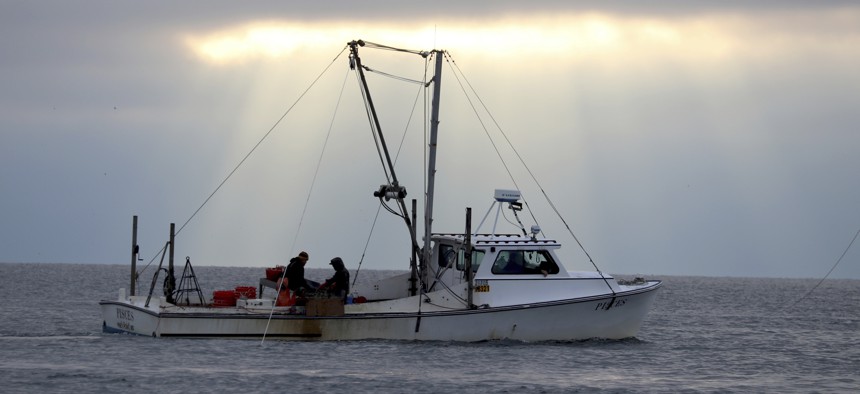Lawmakers Push to Restore Waterway, Coastal Storm Assessment Funds

In a Tuesday, Nov. 19, 2019 photo, watermen dredge for oysters on the Chesapeake Bay in southern Maryland near Ridge, Md. AP Photo/Brian Witte

Connecting state and local government leaders
The Trump administration has proposed significant reductions to a program that funds cleanup in the Chesapeake Bay and stopped funding studies that seek to address threats posed by coastal storm-related flooding.
State and federal lawmakers are pushing back against the Trump administration’s proposal to severely cut restoration funding for the Chesapeake Bay and its decision to halt several studies aimed at finding solutions to protect communities along the East Coast from storms.
Maryland Governor Larry Hogan this week sent a letter to congressional leaders asking them to restore funding for the Chesapeake Bay Program, which oversees initiatives to clean and restore the health of the nation’s largest estuary. The Trump administration’s 2021 budget proposal cuts Environmental Protection Agency funding for the program by 90% to just $7.3 million.
Hogan, a Republican, called Trump’s proposal to cut funding “short-sighted” and said it goes back on prior commitments to increase the amount of money allotted to the program.
“Maintaining strong federal support for the Chesapeake Bay Program, as well as the scientific and modeling framework that underpins the effort, is essential to enhancing, protecting and restoring the waterway’s health and economic vitality of the region and nation,” Hogan wrote in the letter.
A spending plan for this year that was approved by President Trump and Congress in December increased the funding for the bay program to $85 million.
The president’s budget proposal is not expected to get much traction in Congress, where the House is controlled by Democrats. It would also completely gut other programs supporting protection and restoration of environmental ecosystems, including the Gulf of Mexico, Puget Sound, Long Island Sound and San Francisco Bay. The budget plan would cut EPA funding for ecosystem protection in watershed regions from $510 million to $331 million, allotting $320 million for the Great Lakes and $3.6 million for South Florida.

A White House budget document explaining the proposed cuts differentiated between the watershed programs, saying it was necessary to to put money into the Florida and Great Lakes programs because they "present a uniquely Federal role due to the need for continuous long-term monitoring in these complex watersheds." Local and state groups can't take on these responsibilities, it reads.
In contrast, the White House defended eliminating funding of the other programs by saying they should be handled by local and state organizations.
“These programs perform local ecosystem protection and restoration activities, which are best handled by local and state entities,” states the budget document. “State and local groups are engaged and capable of taking on management of clean-up and restoration of these water bodies.”
Congressional lawmakers, including Sen. Mark Warner, a Virginia Democrat, and Rep. Andy Harris, a Maryland Republican, have pledged to fight for restoration of money for the bay program.
Lawmakers hailing from across the Eastern seaboard are also concerned with the environmental impact of other surprise cuts that have halted several studies examining storm surge protection proposals in New York, New Jersey and Maryland. Unlike the proposed cuts to the Chesapeake Bay program, reductions to the U.S. Army Corps of Engineer budgets have already taken effect and halted progress on several projects. The New York and New Jersey cuts were “due to a lapse in federal funding,” NJ Advance Media reported. A $3 million Army Corps study to examine ways to protect the Baltimore area from storm-related threats has also been put on hold because it was not funded in the agency's current fiscal year work plan, the Baltimore Sun reported.
In the wake of Superstorm Sandy in 2012, the corps has been considering ways to protect coastal areas from the sea-borne effects of climate change. Its most costly recommendation to date has been the construction of a $118 billion, six-mile long sea wall in New Jersey and New York. Trump mocked the proposal last month.
Catherine McCabe, commissioner of the New Jersey Department of Environmental Protection, which has also helped fund the two studies, said she was “deeply disappointed” by the cuts.
“While not all of the projects studied may have been pragmatic, what is lost by this suspension is protection for many vulnerable New Jersey communities that would undoubtedly benefit from the smaller more strategic and cost-effective projects that were also included within these studies,” she said.
New York Governor Andrew Cuomo said the cuts were part of a broader move by Trump to punish Democratic states that do not politically support him.
New Jersey lawmakers vowed to fight the cuts.
“We’re certainly not going to accept any downgrading of the responsibility that the Corps has or that the government has to Sandy victims,” U.S. Rep. Bill Pascrell, a New Jersey Democrat, told NJ Advance Media.
Andrea Noble is a staff correspondent with Route Fifty.

NEXT STORY: Responder data-sharing test shows need for ‘bombproof’ tech




